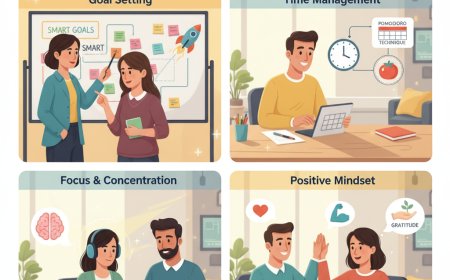Microshifting: The Flexible Work Style That Improves Both Mental Health and Output
Learn how the microshifting work style supports mental well-being while improving productivity by breaking tasks into focused, manageable time blocks for everyday workflow.

The practicality of working in a certain way lasted for a long time: from 9 AM to 5 PM at a desk, perhaps a short break for lunch in between. This was the classical manner of working. Nonetheless, to be honest, is it possible for your brain to keep such high concentration for that long? The truth is that it is only a way to build up stress, to get burnt out quickly, and to waste time with your eyes just glued to the computer screen if you work long hours without taking a break.
Work simply can’t be done all at once. You have scheduled meetings, family obligations, or simply times when your batteries run out, so to speak. The silver lining? Work has been completely transformed, and the new way of working has emerged. It is termed as microshift, and it can be the most human and most effective way to approach your job at the same time.

What is a Microshift? It's Not Just a Break!
To grasp the concept of microshifting, we must first consider the working styles as a whole. Most people have adapted to the most common work styles like "remote" and "hybrid." These are purely about where you work.
A microshift changes the timing and focusing of your work.
The Simple Definition
A microshift is the technique of switching your regular workday into mini, very focused time blocks. These blocks are flexible and depend on your energy levels, not only on the clock.
Instead, you turn one long, tiring 8-hour race into short sprints. Imagine sessions of 25 to 90 minutes, followed by a real break for regeneration. You are not cutting the time; rather, you are making it more effective with a better method.
Expertise and Evidence: The Science Behind the Shift
This idea is not merely a fad; it has scientific support. Human attention operates in cycles. Research on concentration, such as studies of ultradian rhythms, as well as the well-known Pomodoro Technique (25 minutes of work, followed by 5 minutes of rest), reveals that our cognitive activity rises and falls naturally.
The microshift method simply means you are in sync with the body's rhythm. More so, you perform difficult assignments when your attention is at its peak, and you stop working as soon as your focus starts to dwindle. It is thus a customized work style that ensures the highest quality of each work hour.
The Double Win: Mental Health and Higher Output
Microshifting's positive effects are enormous for your mental health as well as your output.
1. A Shield Against Burnout (Mental Health)
One of the significant contributors to stress is the nonstop, continuous working hours. Being in the "on" position all the time will lead you to a crash sooner or later.
The Microshift Solution: By the short and obligatory pauses, the brain has recovered fully during a microshift. Rather than just making it through the day, you are rejuvenated. This leads to a significant reduction in mental fatigue. What follows? You experience less stress, feel more empowered, and your personal life suffers less from the concerns related to work. The transition from being time-focused to being energy-focused is the factor that makes it possible to safeguard your mental health.
2. Personalizing Productivity (Output)
For a long time, the question "What is my work style?" kept repeating. The answer was always related to a job title or a setting. Now it’s about you.
The Microshift Solution: In case you are a "morning person," you can have your hardest concentration work scheduled from 7:00 AM to 10:00 AM. If you are a "night owl," you can reserve the creative tasks for the night. The quality of your output automatically goes up when you work in line with your peak energy. Studies indicate that a significant number of people are ready to sacrifice some of their salaries just for the sake of having such a schedule control, thus highlighting the high demand for this flexibility.
Real-Life Examples: Microshifts in Action
Micro-shifting is not only impacting techies or non-employees. It is literally changing the way work itself is conducted across all industries:
The Caregiver's Rhythm:
Picture a parent who works outside the home. A regular 9-to-5 schedule is out of the question when one has to handle the school run or look after a family member. But with microshifting, they can carry out two hours of uninterrupted work from 7:00 AM to 9:00 AM, rest from 9:00 AM to 11:00 AM for personal tasks, and then get back to work for another block in the afternoon. The entire work is done at the best quality, but the workday is still flexible.
The Meeting Overhaul (A Corporate Microshift):
One executive who was experiencing a lot of workplace stress found out that the main cause of his problem was the never-ending and unproductive meetings. They enacted a straightforward microshift policy: every meeting must last either 25 or 45 minutes and never an hour. This minor adjustment, in turn, resulted in a natural 5- or 15-minute break between meetings. During this time, the employees were able to think, stretch, and get themselves ready mentally for the following task—this helped to improve focus and reduce meeting tiredness all over the company.
The Student/Freelancer Model:
A student who is balancing courses and having a side job would see a microshift as doing a client project for one and a half hours, then studying for an hour, and going back to the side job. This strategy helps to distribute the energy of a single worker among multiple tasks and allows when their concentration is at its best to manage both tasks. This is considered to be one of the most desirable methods of working for the youth.
Making Microshifting Work: Trust and Structure
Microshifting has great power, but it requires unambiguous regulations to thrive. The best flexibility is under a well-defined structure.
The companies and, to a lesser extent, the employees, adopting these working styles would have to change their perception from presence to results.
1. Set Core Hours for Overlap: The teams should come up with some "core hours" (e.g., 1 PM to 4 PM) on which everyone would be logging in for urgent meetings or synchrony collaboration. The rest of the work can be done through microshift bursts.
2. Outcomes Over Hours: The managers should rely on the employees' abilities to produce the expected work. The timing of the work is not relevant as long as it satisfies the quality requirements and the deadlines are met.
3. Set up the Limits: The flexibility does not imply being "always available." During a break or after work hours, employees should completely disconnect. This is the protection of the very mental health that the microshift is intended to improve.

Conclusion: The Future is Flexible
Work's future is not merely a question of five fixed days at a fixed office. It is, rather, an intelligent and flexible approach to work. The microshift is the logical and natural step of the working world. Choosing the work style that is flexible, you are thereby choosing to respect your brain's natural rhythms, safeguard your mental health, and produce higher-quality work than ever before.
It’s a mighty transition from the inflexible past. You can ask yourself: what is the current work style of mine, and how may I introduce the first microshift of mine today? It is a good idea to start small—conduct a 25-minute focused sprint and then take a 5-minute walk. You might discover that this minuscule change results in a major enhancement of your life.
The discussion about work styles is just starting. What strategies can companies use to align these flexible models with working parents, students, and people with varying energy levels? The human-centered approach to determining which companies will be rated the best in the coming years will soon become the new trend in business.
What's Your Reaction?
 Like
0
Like
0
 Dislike
0
Dislike
0
 Love
0
Love
0
 Funny
0
Funny
0
 Angry
0
Angry
0
 Sad
0
Sad
0
 Wow
0
Wow
0

























































































































































































